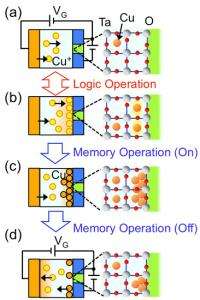Novel transistor combines logic and memory functions, drastically reduces power consumption

A group headed by Dr. Tsuyoshi Hasegawa, a Principal Investigator at the International Center for Materials Nanoarchitectonics (MANA; Japan), succeeded in the development of a novel transistor, the "atom transistor," which performs both logic and memory functions while reducing power consumption to 1 x 10-6 that of the conventional devices. Logic elements which are capable of retaining their state (i.e., memory) will be indispensible for the development of instant-on personal computers (PC) and other electronic equipment. The development in this work is expected to accelerate the realization of these devices.
In contrast to conventional transistors, which control the movement of electrons in a semiconductor, the newly-developed “atom transistor” operates by transferring a very small amount of metal atoms in an insulator. By using an insulator, which has higher resistance than a semiconductor, as the base material, and realizing on/off states by transfer of a tiny amount metal atoms in this material, the new device achieves a high on/off ratio on the same level as conventional semiconductor transistors with extremely low power consumption.
Furthermore, it was found that the “atom transistor” also operates as a memory element which retains states by control of the operating voltage range.
As non-volatile logic circuits, which reconfigure circuits corresponding to computational results, are able to retain their state even when the power supply is turned off, high expectations are placed on the developed device as a new type of computer circuit for realizing PCs with zero starting time. Conventionally, one “logic element with memory” was formed by combining a logic element (transistor) and a memory element (memory).
However, with the conventional devices, the power consumption required for memory is extremely high, and low power consumption, in which memory power requirements are greatly reduced, had been considered necessary for practical application. The “atom transistor” developed in this research reduces the power consumption required for memory to 1/1,000,000 that of the conventional technology. In addition, because it possesses both logic and memory functions, it is expected to contribute to the realization of neural computing systems.
More information: These results were published online by the scientific journal “Applied �鶹��Ժics Express (APEX)” on December 24, 2010. Title of paper: Volatile/Nonvolatile Dual-Functional Atom Transistor. Authors: Tsuyoshi Hasegawa, et al.
Provided by National Institute for Materials Science

















